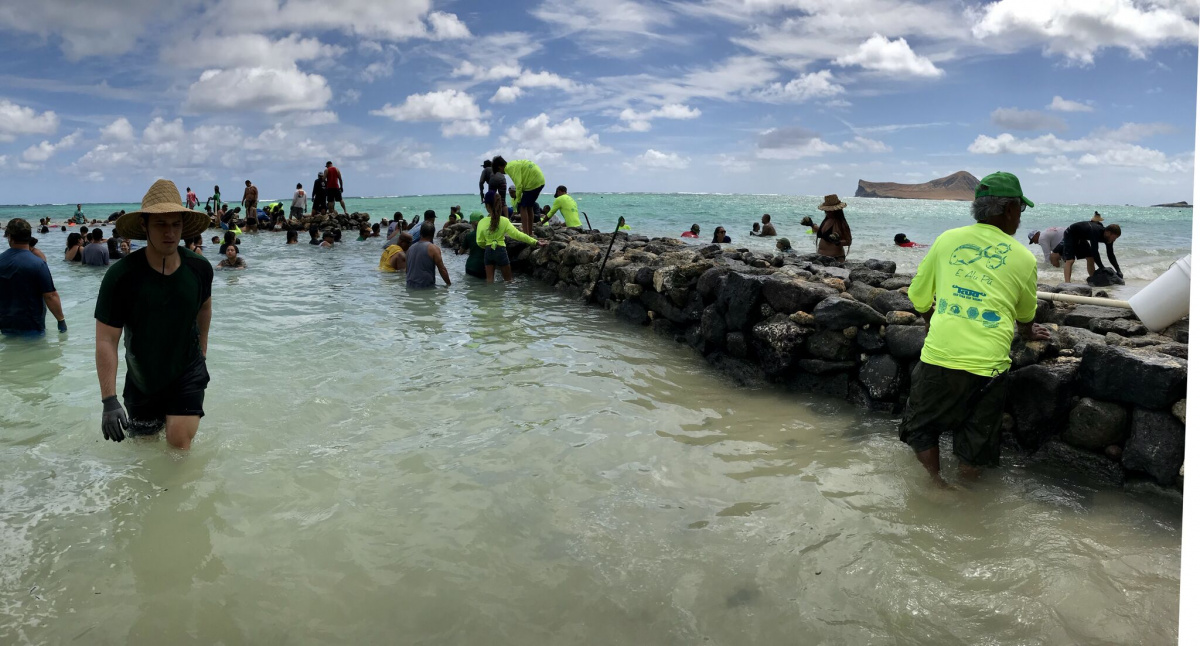Community-based Conservation
CEESP News: by Fikret Berkes, University of Manitoba*
As more and more terrestrial and marine regions come under protected area status, the idea of community-based conservation becomes increasingly interesting. How do IUCN protected area categories V and VI work with people in them? Can Indigenous and Community-conserved Areas (ICCAs) contribute to conservation? How does community stewardship work?

Photo: Kim Moa
Biocultural restoration: Hawaii’s ahupua’a land and coastal management systems almost disappeared after colonization, but they are being restored in some areas. The photo shows re-building of stone walls of a traditional fishpond (part of ahupua’a) by communal effort in O’ahu Island (Photo: Kim Moa).
This current IUCN CEESP Newsletter was not intentionally designed to be about “Community-based Conservation”. But it got this designation because of the sheer number of contributions on and around this theme. Consider:
- coastal community associations for sustainable development in Kenya (Bowden);
- community conservation area volunteers safeguarding over-wintering Oriental Storks in China (Wong et al.);
- communities combating coral reef destruction in Malaysia (Ramakrishnan);
- coral reef restoration driving marine ecosystem training and management in Fiji (Bonito);
- the development of protected areas (PA) assessment tools, perhaps suited for community management (Stolton and Dudley); and
- new books related to this topic, Advanced Introduction to Community-based Conservation (Berkes), and Making Commons Dynamic (Nayak).
The 30 Percent Solution and Community-based Conservation
As CEESP members well know, there are limits to the numbers and total area of protected areas (PAs) that can be established. At the same time, there is a need to move from the notion of human-free “islands” of conservation to one in which humans co-exist with the natural world. Community-based conservation is part of this effort to restore stewardship traditions and build new ones. The articles in this issue of the Newsletter provide illustrations of the diversity of ways in which this can be done.
Conservation cannot rely entirely on community action; the world is much too complex and interconnected for that. Rather, community-based conservation starts at the local level with citizens, local associations, and local institutions that work with other levels of governance. As shown by the stork case and others, local action has to coordinate with other levels of governance, sometimes compelling them to engage in more effective conservation by providing incentives and political space.
Biocultural Approaches and Restoration
One of the ways in which community-based conservation differs from conventional conservation is attention to the interconnection of nature and culture, the biocultural approach. Cultural diversity is in part driven by biodiversity, and that biodiversity (especially crop biodiversity) is in part a product of human cultural practices. The two kinds of diversity co-evolve in a two-way relationship, which results in cultural landscapes over much of the world, as in IUCN Category V PAs.
Thus, ecosystem restoration in many places is in effect biocultural restoration of integrated social-ecological systems, as in the item on Fiji. And who protects this unique ecosystem type? The Malaysia article shows that it is the communities that combat reef destruction. These articles are only two examples of biocultural restoration that is currently going on in many parts of the world, from mangrove restoration over much of Southeast Asia to traditional ahupua’a restoration in Hawai’i (see above photo).
Indigenous-led PAs and ICCAs
One of the most exciting kind of PA initiatives are those spearheaded by Indigenous groups. About 20 percent of Indigenous peoples’ lands are already within PAs, making up about 40 percent of global PAs. In Australia, Indigenous PAs constitute about 50 percent of the National Reserve System. Indigenous peoples (“traditional owners”) can decide whether to designate their lands as PAs or not, and on the kind of co-management to govern these lands.
As summarized in the Advanced Introduction to Community-based Conservation (Berkes), Canada (as elsewhere) is in the midst of developing Indigenous-led PAs, some of them very large. Still in formative stages, Tallurutiup Imanga in the Eastern Arctic covers 109,000 sq km, Canada’s largest PA. Two notable characteristics of these new PAs are joint governance and the formal involvement of Indigenous peoples as stewards.
Key Role of Local Institutions in Conservation Governance
Institutions refer to rules-in-use, following the Nobel laureate Elinor Ostrom. Community-based conservation requires active local institutions. These could be formal governmental institutions. Or more commonly, as in many ICCAs, they could be informal institutions. That does not make them any less “real” in making and enforcing rules on the commons, a point that Ostrom loved to make.
The book Making Commons Dynamic (Nayak) includes examples from many parts of the world, covering diverse types of resources. These examples provide insights regarding the processes by which lands and resources become jointly used under commons institutions and collective action (commonisation), and the circumstances under which joint use and collective action fail (decommonisation).
The pessimists often use examples of conservation failure. But it is important to know that it is also possible to build institutions for sustainability. In fact, all the cases of PA co-management in Australia, Canada and elsewhere are examples of commons institution-building toward conservation.
As Advanced Introduction to Community-based Conservation argues, biodiversity conservation is in the process of being transformed from biological management to interdisciplinary governance. Community-based conservation is a key ingredient of this transformation. Making Commons Dynamic reveals the tremendous potential for new commons institutions at the grassroots. Along with the IUCN publication, Communities, Conservation and Livelihoods (Charles) which was highlighted in the last Newsletter, these three books signal an emerging consensus toward a socially just, democratized kind of conservation in which communities are part of the ecosystem and possess stewardship institutions to conserve not just biological diversity but biocultural diversity.
* Dr. Fikret Berkes is Distinguished Professor Emeritus at the Natural Resources Institute, University of Manitoba, Canada. Dr. Berkes’ work deals with social-ecological resilience, commons, co-management, and local and traditional ecological knowledge. His eleven books include Advanced Introduction to Community-based Conservation (Edward Elgar, 2021) and Sacred Ecology (4 th edition, Routledge, 2018).



